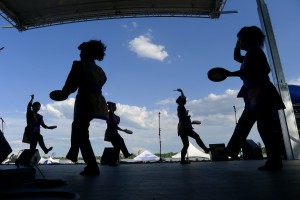 It struck me towards the end of the first day of the Colorado Dragon Boat Festival that the clash of cultures I had just witnessed perfectly encapsulates why I’ve been a volunteer for this event since it was started in 2001.
It struck me towards the end of the first day of the Colorado Dragon Boat Festival that the clash of cultures I had just witnessed perfectly encapsulates why I’ve been a volunteer for this event since it was started in 2001.
(Full disclosure: Last year, my partner Erin Yoshimura took on the role as executive director of the festival, after volunteering from the beginning. I help out with media, the website and emceeing on the main stage.)
As the first day of the two-day event came to a close, the main stage lineup included a sampling of performers from the festival’s very popular Cultural Unity stage, a showcase of Colorado’s diverse hip-hop community.
The hip-hop sampler was fantastic – and showed why their stage is always so jammed that you can barely see through the crowds surrounding the tent, especially when the dancers are spinning on the ground.
The elevated main stage offered an eye-popping view for the audience, most of whom hadn’t gone by the Cultural Unity area before. The performance was a 20-minute introduction to the artistic principles and driving aesthetics of hip-hop culture, starting with naked rhythm from a conga drum, then showing the evolution of the rhythm into the DJ’s scratching with turntables and vinyl records.
Then the B-boys and B-girls assembled around the stage in a half-circle took turns strutting their stuff to the rhythmic riffing, spinning, flipping and contorting their bodies into unbelievably elastic poses and leaving the audience agog.
The set emphasized the multicultural appeal of hip-hop and pointed out how the performers on stage with him ran the ethnic gamut: Asian, Caucasian, African American, Latino.
Following the Cultural Unity sampler, which drew a huge crowd to the stage, most of the audience stayed for the Colorado Okinawa Kenjinkai, a group of women from Okinawa who preserve the traditional dances of Okinawa, a culture that’s distinct from Japan.
Continue reading












